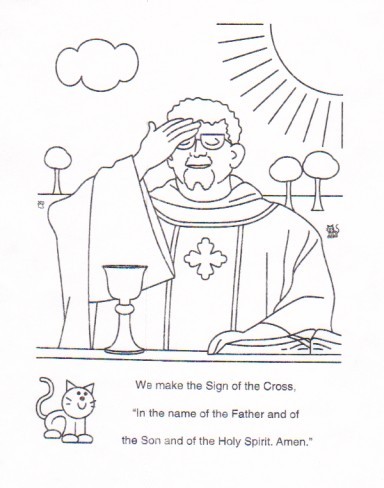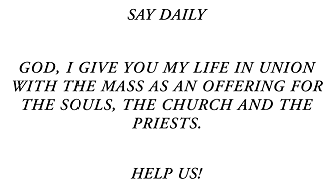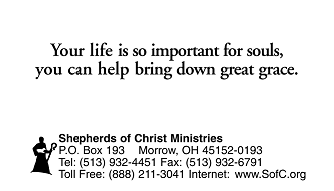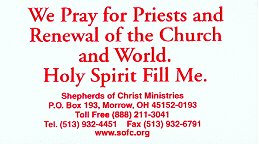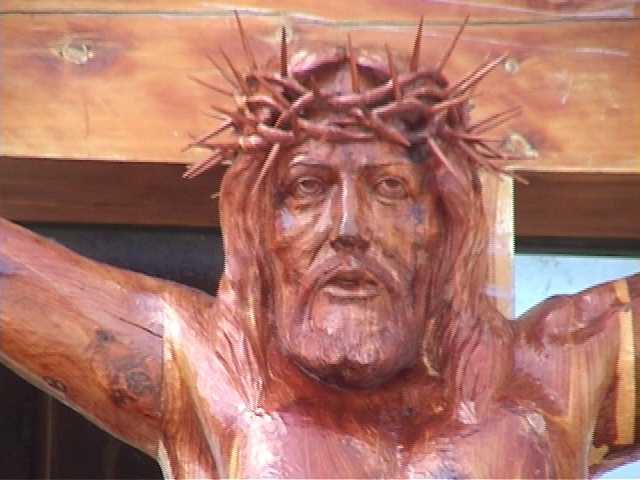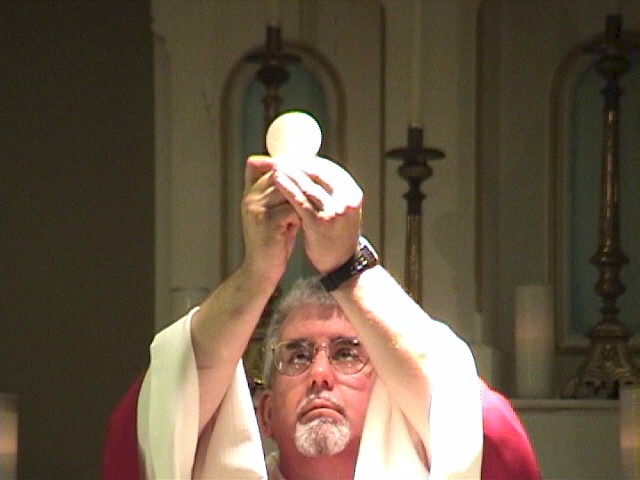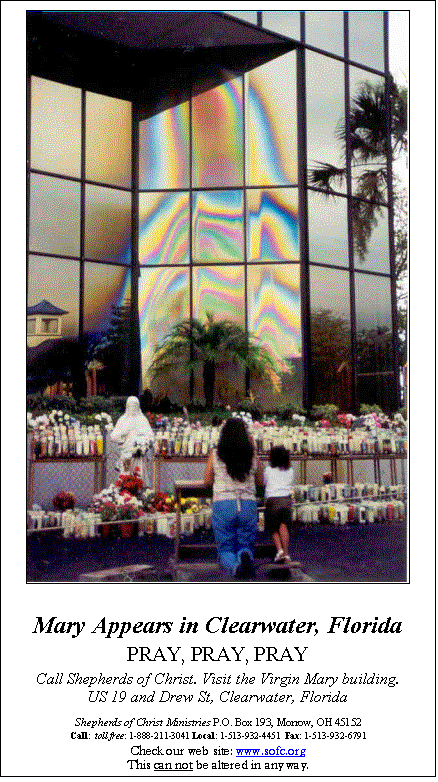6
The Christian and Church
God calls us to live the Christian existence, the spiritual life, within the
framework of the Church that Jesus has established. This Church is a many-splendored
reality; it has many different names, images, and dimensions that variously
attest to and manifest this multifaceted richness. All of them, however, speak
of one and the same reality; each in its own way emphasizes now this, now
that, particular truth or truths of the Church's existence. Each of these
dimensions or concepts of the Church has something to say to the individual
Christian about his or her spiritual life. Let us briefly consider some of
these facets.
The Church is the Body of Christ. One of the truths that is emphasized by this
concept is the idea of community. The communion that binds the members of the
Church together is, in turn, connected with that wider idea of community that
embraces the whole of mankind.
The millions and millions of people the world over make up what might be
called the world community. The members of this cosmic community are supposed
to live in a basic love for one another, united in bonds of mutual support and
interdependence. This is true because God has created persons as social
beings. We are not intended to cut an isolated path through life. We are meant
to walk hand in hand with each other, to live within a societal structure, to
help others in many different ways. What is more, we must also realize that,
in achieving our destiny, we receive much aid, support, and love from others.
There are all too many striking examples of how the modern world has failed to
live community—more than enough to make us agonize over man's inhumanity
toward his fellow human beings. But there are also many beautiful and ongoing
examples of how the world has succeeded in living community—enough to
strengthen our belief in the basic goodness of the human heart.
The leader in helping form a better community among the members of the human
family is the Christian community, the Body of Christ. God has established the
Church as a leaven for the development of a graced society of human beings.
The bonds of union that hold the human race together have been strengthened by
the redemptive work of Christ. Despite the fact that many do not realize it,
there is only one fundamental community that embraces everybody—and it is Christic.
The Christian community is, in turn, a great channel of grace that deepens
this Christic image of the world society.
If the Church is to be a proper leaven for the formation of a better world
community, however, she herself has to progress in a sense of community. There
must be a growing understanding of the truths and principles that pertain to
Christian community, and a growing desire to explore practical ways to
implement these principles.
Throughout the course of salvation history, God has always communicated
himself within the framework of community. In saying this, we are not
maintaining that God does not communicate himself to individuals in a very
intimate and personal manner that respects their uniqueness, their
individuality. We are saying, however, that God communicates himself to a
person according to his or her totality, and one dimension of this totality is
the social aspect. God has respected this social dimension; in his
self-communication he has called us together in religious community, or
covenant. It seems that in our present age God is beckoning us to a deeper
realization of these truths.
The Christian community is a terrestrial reflection of the ultimate and
absolute community—namely, the Trinity. In a special way, we are privileged
to give witness to Trinitarian life, a life of divine intimacy and loving.
From all eternity, the persons of the Trinity are united in the most intimate
bonds of knowledge and love; these have also brought about creation and
redemption.
Grace, or the Christ-life, is a created participation in Trinitarian life.
This Christ-life, consequently, calls us to a special existence of knowing and
loving. Christian faith and love, which are created participations in the
Trinity's knowing and loving, allow us to know and love God in a special
manner. Faith and love also give us a new capacity to relate to both our
fellow Christians and to all others as well.
Because the life of the Trinity is person-centered, so must the life of the
Christian community be person-centered. For many years, it seems, we were not
sufficiently person-conscious; however, the theology that has emanated from
Vatican II is helping to rectify this situation. In the pre-Vatican II Church,
structures in the Church were occasionally treated as ends in themselves
rather than as the means of serving the persons in the Church. Slowly but
surely, structures in the Church are being renewed so that they might better
serve their true purpose, which is to aid in the ongoing development of her
members.
The Christian community, in turn, develops when those who make up that
community develop as authentic Christians. Just as each divine person
contributes perfectly to the community life of the Trinity according to the
perfect fullness of his personhood, so each Christian contributes to community
life in proportion to the degree of his or her personal development.
Authentic interpersonal relationships help to develop community. The
Trinitarian community is a community of profound relationships. Because we
reflect Trinitarian community, we are intended to have relationships not only
with the persons of the Trinity, but likewise with one another. Authentic
interpersonal relationships not only unite in a deeper knowledge and love the
persons directly involved, they also make a person more capable of loving
others more deeply and, therefore, more capable of deepening the bonds of
total community. If a person is growing in the capacity to love his or her
friends, for example, that person is concurrently growing in the capacity to
also love others—both those who are members of the Church and those who are
not.
The concept of the Church as Body of Christ certainly emphasizes the sense of
corporateness that should permeate the consciousness of the Church's members.
We must think in terms of both what is good for the entire Church and, through
this Church, what is good for the total human community. Even when we disagree
among ourselves, we do so not because we want to glory in having the upper
hand, but because we believe that to disagree here and now is necessary so
that the truth might better emerge for the good of the community. St. Paul
speaks to us about this sense of corporateness: "In the name of the
encouragement you owe me in Christ, in the name of the solace that love can
give, of fellowship in spirit, compassion, and pity, I beg you: make my joy
complete by your unanimity, possessing the one love, united in spirit and
ideals. Never act out of rivalry or conceit; rather, let all parties think
humbly of others as superior to themselves, each of you looking to others'
interests rather than his own" (Phil 2:1-4).
In our sense of corporateness, that is, motivated by a common purpose and a
common good, we should learn to rejoice in the gifts and the achievements of
others. These are not isolated gifts and achievements; rather, they redound to
the good of the whole body. We all probably know of numerous instances of
jealousy and a false sense of competition that have hindered the work of
Christ. In the long run, however, if the work of Christ is being accomplished,
and if I am making an effort to do my part, does it really matter whether I or
someone else is responsible for this or that particular accomplishment? Does
it matter whether this or that group or organization receives credit? St. Paul
again has words for us: "After all, who is Apollos? And who is Paul?
Simply ministers through whom you became believers, each of them doing only
what the Lord assigned him. I planted the seed and Apollos watered it, but God
made it grow. This means that neither he who plants nor he who waters is of
any special account, only God, who gives the growth. He who plants and he who
waters work to the same end" (1 Cor 3:5-8).
Apparently, a growing number of persons today are tempted to think that they
do not need the Church and its bonds of communion in order to be Christian. In
fact, some say the Church is a hindrance to them in their attempts to live the
Gospel message. Their uniqueness—their individuality—is being thwarted,
they claim. This is a temptation that must be firmly resisted. There is, of
course, an errant philosophy of individualism rampant in today's world that
can certainly influence the contemporary Christian. This philosophy is
patently false. It promotes a type of individualism that is inimical to
community because it teaches that one must look out for Number One regardless
of the consequences to others. Do your own thing, in other words, whenever and
wherever you please, and let the chips fall where they may. This type of
individualism is obviously wrong and pernicious.
There is, on the other hand, a kind of individualism that is positive and in
perfect harmony with the tenets of community. This theory states that the authentic
expression and development of individuality, of uniqueness, actually
contributes to community, and, conversely, life within the community enhances
one's true individuality. Rahner puts it this way: "An absolutely
individual Christianity in the most personal experience of grace and ecclesial
Christianity are no more radically opposed than are body and soul, than are
man's transcendental essence and his historical constitution, or than are
individuality and intercommunication. The two condition each other mutually.
The very thing which we are from God is mediated in the concreteness of
history by what we call church. And it is only in and through this mediation
that it becomes our own reality and our salvation in full measure. For this
reason church exists and has to exist" (Foundations of Christian Faith,
p. 389).
Closely connected with the concept of the Church as Body of Christ is that
dimension which is sacramentality. Both aspects—the Church as Body of Christ
and as sacrament—emphasize the fact that the Church exists in, with, and
through Christ, and that the Church is the tangible, visible, terrestrial
continuation of the Incarnation. As would be expected, then, both concepts
emphasize some of the same truths. What can be said about the Church as
sacrament could also be said about the Church as Body of Christ. To put it
another way, a dimension of the Church being Body of Christ is her
sacramentality. We will examine this sacramentality in a general way,
momentarily postponing the treatment of liturgical sacramentality until the
next chapter.
In a general sense, then, a sacrament is a visible sign of an invisible,
divine reality. Christ, therefore, is the primordial sacrament given to us by
God. In his historical existence, Jesus was the visible, tangible
manifestation that God has irrevocably entered our world with merciful,
salvific grace. At the same time, Christ contained within himself this divine
reality that he externally manifested. Thus, we quickly arrive at a fuller
definition of sacrament in general—namely, a sacrament is a visible sign of
an invisible, divine reality, that contains and confers what is signified.
The Church continues the work of the Incarnation. With Christ as head of the
body, the Church continues the life and the work of Jesus according to the
pattern and characteristics of Christ himself. Because Christ's existence was
centered in death-resurrection, for example, so also is the Church's existence
centered in death-resurrection. Similarly, in our present context, because
Christ was sacrament, so also is the Church sacrament. Avery Dulles says:
"The Church therefore is in the first instance a sign. It must signify in
a historically tangible form the redeeming grace of Christ. It signifies that
grace as relevantly given to men of every age, race, kind, and condition.
Hence the Church must incarnate itself in every human culture" (Models
of the Church, p. 63).
The individual Christian participates in the sacramentality of Jesus and the
Church. In some ways, this participation differs according to one's vocation;
a lay person, for example, does not participate in all ways the same as does
the priest. There are, however, some ways we all share in common, one of which
is our privilege and responsibility of signifying God's love. Because God in
his love was the principal reality signified by Jesus in his incarnate
existence, we, who help continue the Incarnation, must make the manifestation
of love our principal concern. We must make sure that it is the controlling
force of our Christian existence. We all know countless examples of Christians
who have given outstanding witness to God's love, and the achievements to
which that love can inspire others. History shows how Christians of all
vocations have marvelously and, at times, brilliantly, spent themselves for
one another and for mankind in general. In all honesty, however, we know that
there is also a darker, unattractive side to our history. There are numerous
and painful examples of how Christians have failed to give witness to the love
that Jesus came to preach. We cannot undo these failures, but remembering them
can help motivate us to repair the damage by loving—here and now—as we
should.
Another dimension of the Church is the fact that she is a pilgrim Church, a
fact that we have alluded to in an earlier chapter. This concept has various
ramifications: A pilgrim Church, for example, has not yet arrived at her final
destiny, has not yet achieved that fullness, that perfection, that complete
maturity that will be hers only when she joins the heavenly Church—that
portion that has already achieved eternal life. To be a mature member of a
pilgrim Church, then, is to realize that there will always be many
imperfections that will mar the beauty of the Church. Although these failings
dim the Christ-like image of the Church and thus prevent her from projecting
Christ to the world as well as she otherwise could, we have to realize that,
to a certain degree, the Church will always be burdened with such failings.
Liberals are correct, however, when they call for a renewal of the Church that
would better enable her to be what she should be. They are correct in pointing
out that a pilgrim Church is one that should be evolving, progressing,
searching for the path that has been marked out by the Lord, and always
pressing on toward that which has not yet been achieved. But if liberals are
eager to view the Church according to such an imperative, they also must be
willing to accept the fact that the concept of a pilgrim Church is a two-edged
sword. If such a concept points out the truth that the Church must, to a
certain extent, always be progressing, changing, renewing herself, it also
points out the truth that a pilgrim Church will always be burdened with
failures and sinfulness. If she were all she should be, in other words, there
would be no need for change or renewal or evolution.
Conservatives, on the other hand, must realize that a pilgrim Church must be
on the move, adapting, reaching out for that aspect of the Gospel ideal that
has not yet achieved. To opt for the status quo, to have a triumphalistic
attitude regarding the Church, is to reject the idea of a pilgrim Church—it
is, in short, to reject reality. Conservatives are correct, however, in
pointing out that change and progress can never mean compromising the timeless
essentials that are irrevocable constituents of the Church's existence.
The challenge for all of us, then, whether we be liberals, conservatives, or
centrists, is obvious: We must learn how to more perfectly unite the
unchangeable and changeable aspects of the Church; we must courageously bear
with the failings and sinfulness of the Church while, at the same time, we
must take all reasonable means to improve the situation; we must deeply love
the Church while, at the same time, we must admit that she has a long way yet
to travel; lastly, we must be willing to give ourselves so that we might
accomplish this goal.
Another dimension of the Church is the fact that, by her very nature, she is
capable of expressing both diversity and unity. Exactly how to combine both of
these aspects in a proper balance is one of the greatest challenges facing the
Church today. We are still far from the desired balance—an unpleasant
reality that is made manifest by the spirit of divisiveness that plagues the
contemporary Church. This divisiveness has, to a considerable degree, been
caused by the recent pluralism, or diversity, that is a leading characteristic
of the post-Vatican II Church. Pluralism, or diversity, in itself is not
undesirable—far from it; rather, it is that we still have much to learn in
dealing with pluralism, in being able to discern the difference between
authentic pluralism and its nonauthentic counterpart, and in blending the
pluralism that is desirable with the unity that is necessary.
Let us reflect on some of the factors that give rise to pluralism in the life
of the Church. First, let us consider the mystery of Christ as it is relived
by both Church and individual Christians. The People of God, individually and
collectively, are meant to continue the Incarnation in space and time by
reliving the life, death, and resurrection of Christ—the mystery of
Christ, which is both richly diversified and profoundly unified.
Jesus has left us many different truths and examples that are to be
incorporated into our own Christian existence. Historically, this rich
variation of the mystery of Christ has manifested itself in various ways. We
have different schools of spirituality, for example, each of which gives a
special witness to this or that aspect of the Christ-event through its own
particular harmonization and implementation of the various facets that
comprise the life, death, and resurrection of Jesus. And so, Carmelite
spirituality has always stressed prayer; it gives special witness to the
Christ who often went aside and prayed to his heavenly Father. Benedictine
spirituality has given special attention to liturgy and, consequently,
emphasizes the priestly activity of Christ. Dominican spirituality has
traditionally stressed the pursuit of truth and, in its own special manner,
points to the prophetic or teaching office of Jesus. Franciscan spirituality
has emphasized, among other things, the material simplicity of Christ's life.
In more recent times, in the effort to apply in a special way the mystery of
Christ to the diocesan priesthood and to the laity, writers have dealt with
the spiritualities that are appropriate to these two vocations. The mystery of
Christ, then, simultaneously possessing a varied richness and a profound
unity, makes possible different spiritual movements that, nevertheless,
ultimately constitute but one Christian spirituality. Consequently, we must
preserve a balanced view. We must admit the legitimacy of varied movements and
schools of spirituality, which have their own particular nuances in the
following of Christ, while, at the same time, we must realize that all
Christian spiritualities are essentially the same. They have very much in
common because they are rooted in the one Christ, in one Gospel, in one
liturgy.
We have established a very basic theological reason for diversity in the life
of the Church—the diversity that is contained in the very mystery of Christ.
There are, however, two more factors we would now like to discuss that help us
to see why diversity exists in the Church. These second and third principles
might well be called the theology of personal uniqueness and the theology of
time and culture.
We have seen in chapter two that the theology of personal uniqueness tells us
that each person is a unique imitation of God. In the process of being
elevated to graced existence through our incorporation into Christ, our
personal uniqueness is deepened. This interpretation is an application of the
theological principle that grace does not destroy or lessen nature; rather,
grace perfects nature and gives it a deepened capacity to more fully actuate
all its authentic dimensions, one of which is personal uniqueness. Our life in
Christ, then, far from lessening or destroying our uniqueness, respects and
develops it.
Various implications that relate to diversity in the Church flow from this
theology of personal uniqueness. There are, as we have said, various spiritual
movements and schools of spirituality in the Church because it is possible to
relive the richly diversified mystery of Christ with different emphases and
nuances. In the same way that this diversity is possible between schools of
spirituality, so also is it possible among individuals. Moreover, it is not
only possible, but actually necessary because of the concept of personal
uniqueness. No two Christians will put on Christ in exactly the same manner;
each one puts on Christ according to what each one is. Obviously, each
Christian is to assimilate Christ in essentially the same manner;
nevertheless, each Christian will also do it in a manner that cannot be
duplicated. Our theology of personal uniqueness, then, has obvious
implications for the overall diversity in the Church, which has millions of
members.
We have seen how diversity is present in the Church because of both the
principle of pluralism, which is contained in the mystery of Christ, and the
principle of personal uniqueness. Now we come to the third and final
principle; it deals with ideas that are contained in what can be called the
theology of time and culture.
In God's dealings with mankind, the concepts of time, historical situation,
and culture have played a very important role. In saving us, God works within
time, history, and culture; his salvific action is not unnaturally
superimposed upon our historical and cultural situation, but rather, works
within it. Throughout the continued course of salvation history, God's saving
will manifests itself differently, or diversely. This diversity can, in part,
be explained by historical and cultural exigency, a classic example of which
is the comparison between the old and the new covenants. God's dealings with
the people of the Mosaic covenant were conditioned both by the point of time
in salvation history that was then operative and the culture of the Jewish
people. With the enfleshment of his Son and the ensuing formation of the new
covenant, God communicated himself in a manner that was partially different
from that self-communication that had prevailed during the time of the Mosaic
covenant.
If God's salvific activity has a diversity attached to it because he respects
the time-conditioned and culture-conditioned situation of man, so must there
be a similarly caused diversity attached to Christian life. The Christian life
is a response to God's loving salvific activity, a response to his living
initiative that always precedes us. God's activity, which respects the
differences that time and culture insert into human history, will exact
differentiated responses within the Church. This differentiation can exist
between the various ages of the Church, and, therefore, we can legitimately
speak of the predominant spirituality of either the sixteenth century or a
certain period within the eighteenth century. This pluralism, or diversity,
can also exist within the same age because of cultural differences; God
respects the African culture, the American culture, and so forth. As
Christians within these various cultures respond to God's continued
self-communication, they do so in a manner that is partly determined by their
particular cultures. Because there are differences in their cultures, we will
discover a Christian pluralism, or diversity, arising out of these cultural
differences. An African spirituality, therefore, differs somewhat from an
American spirituality, and both differ from a Spanish spirituality.
Up to this point, we have been discussing basic truths that offer a sound
theological basis for diversity in the life of the Church. This pluralism,
though it obviously has a place in any age of Christianity, is an especially
important dimension for the contemporary Church. Today's Church offers a
particularly advantageous climate for the development of authentic diversity
in Christian living—a favorable climate that has developed because of the
greater spirit of freedom that is present in today's Church. True, this
greater freedom has been abused in numerous instances; these abuses of
freedom, however, cannot deny that the Holy Spirit seems to intend this
climate of expanded freedom, because it has emanated from the principles of
Vatican II.
The connection between pluralism and a Church that allows a greater freedom of
both thought and expression in lifestyle is obvious. In such a Church, various
thrusts of diversity are bound to fructify more often than in a Church that is
heavily monolithic, whose thought patterns and lifestyle are too much imposed
from the top downwards. The hierarchy will, of course, always have the leading
role in directing the Christian thought and lifestyle of the Church, but it
should do so according to the principle of collegiality, which allows for all
members of the Church to help shape her life. In order for collegiality to
flourish, however, there must be a spirit of freedom, some elbow room in which
to both maneuver and, yes, even make some mistakes. Consequently, even though
some are tempted at times to think that the greater freedom of today's Church
has resulted in more harm than good, fundamentally this is not true. In the
last analysis, such a Church will be a healthier and more mature Church—and,
to be sure, one characterized by a greater diversity.
There are already various examples of an increased pluralism in today's
Church. The liturgy, for one, is now much more diversified than it was in the
pre-Vatican II Church. There has also been considerable discussion and
implementation regarding pluralism in Christian ministry; Christian lifestyle
is considerably more pluralistic today than it was previously; theological
thought now exhibits a much greater pluralism than it had; also, new and
diversified forms of prayer appear to have taken their place alongside
traditional forms. All these examples, not to mention many others, indicate
that life in the contemporary Church is characterized by an increased
diversity.
Three special qualities are necessary in order to live properly in today's
Church with her increased pluralism. These qualities are not mutually
exclusive; there is an overlap among them, yet each has its own particular
nuance. First, then, there is the need for an increased awareness of the
necessity of spiritual discernment. Today's diversity requires that
Christians, more than ever before, know how to listen to the Spirit. Because
of the special importance of discernment in an age of pluralism, we will later
devote a chapter to this topic.
Second, in order to cope properly with today's diversity, we especially need
the quality of Christian maturity. Increased diversity within the Church
demands increased maturity. In the more tightly structured, monolithic Church
of pre-Vatican II days, things were spelled out for us in much greater detail
than they are today. The Church of today asks us to exercise a greater
maturity, a more mature use of our freedom, as we are called upon to live
responsibly in a more pluralistic Church.
Finally, besides an increased sense of both Christian discernment and
Christian maturity, there is a special need today for the spirit of Christian
tolerance—a tolerance of the views and lifestyles that do not agree with our
own. The need for this spirit of tolerance is indeed evident after only a
brief look at what we have experienced in recent years. One of the great pains
that has been felt within the post-Vatican II Church has been caused precisely
by the numerous and diverse viewpoints and lifestyles that have arisen. This
spirit of tolerance, of course, does not mean that we need to condone what we
think is wrong. It does mean, though, that we need to increase our efforts to
be more open to the view of others, admit that a more diversified Church is
intended by the signs of the times, realize that we are likely to make
mistakes in such a situation as we grope for the leading of the Spirit, which,
because of the confusion that both the Church and the world are experiencing
as they undergo radical transition, is occasionally much more hidden than we
would like.
A more diversified Church is what we are experiencing. We might say that it is
too difficult to cope consistently with this situation. Likewise, we might be
tempted to withdraw from the struggle that an increasingly pluralistic Church
demands and carve out our own little niche of Christian existence in which we
could then lead an unperturbed life while all the confusion of a Church
striving for authentic pluralism passes us by. If we surrender to such a
temptation, we would, of course, avoid a certain kind of suffering; however,
we would also be eschewing the joy and sense of accomplishment that result
from contributing our share to the shaping of a contemporary Christian
life—one that is characterized, among other things, by an increased
pluralism.
It is a question, then, of striving to arrive at the diversity that God
intends for his Church—a diversity that is both rooted in the richly
diversified mystery of Christ and simultaneously shares in the profound unity
that permeates this Christ-event. Whatever way the Church might manifest its
diversity, we must always remember that, as Christians, we follow the one and
same Christ, the one and same Gospel.
As we end our discussion of the Church, the Christian community, let us recall
the words of St. Paul: "Let us, then, be children no longer, tossed here
and there, carried about by every wind of doctrine that originates in human
trickery and skill in proposing error. Rather, let us profess the truth in
love and grow to the full maturity of Christ the head. Through him the whole
body grows, and with the proper functioning of the members joined firmly
together by each supporting ligament, builds itself up in love" (Eph
4:14-16).
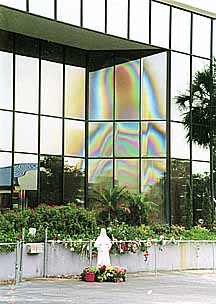

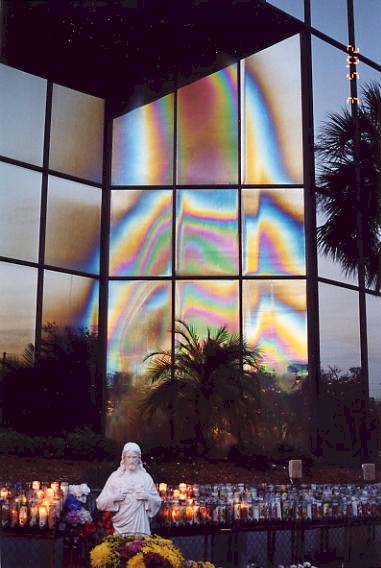
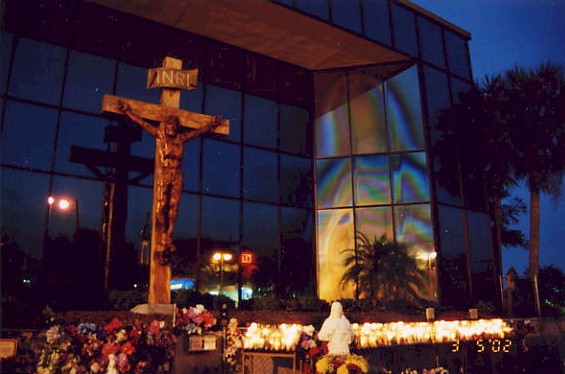
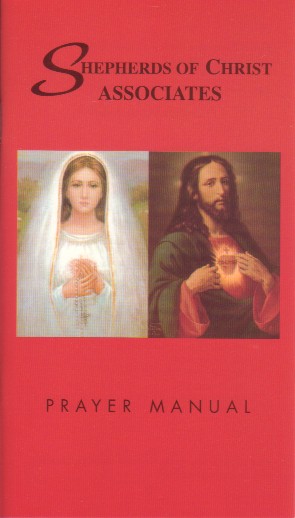
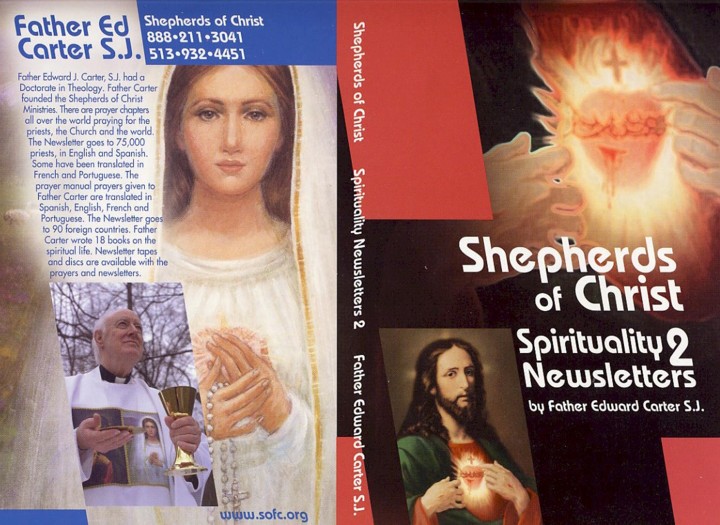
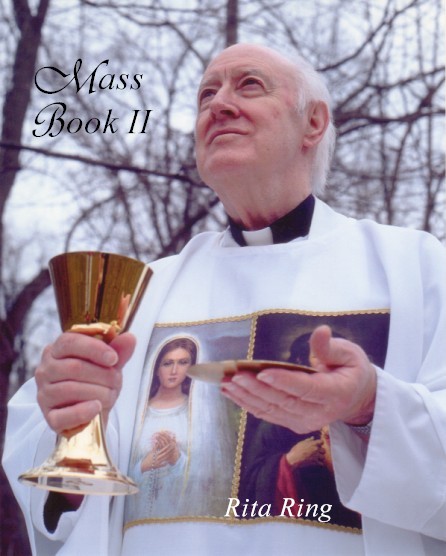




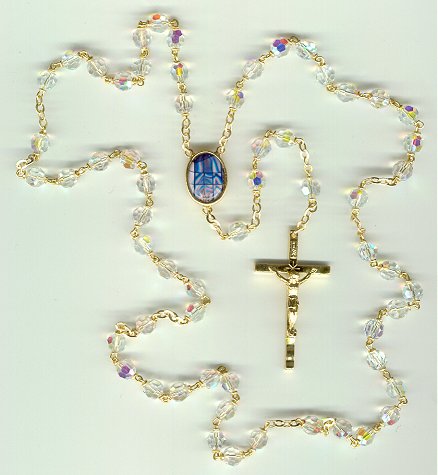
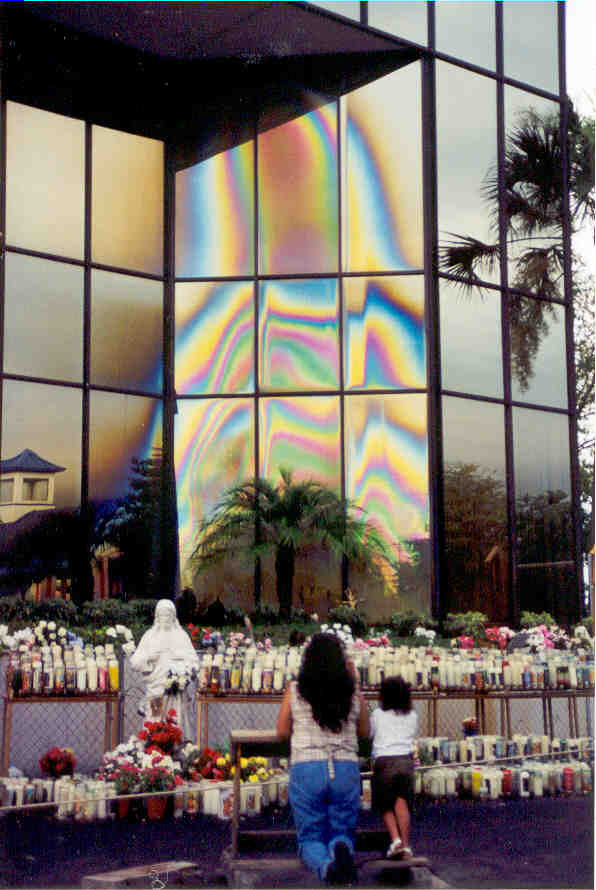
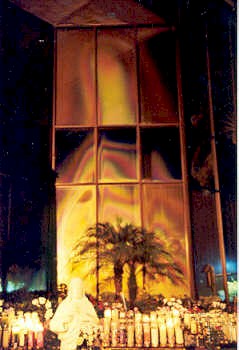


 Mary
talks to the Nursing Homes
Mary
talks to the Nursing Homes
